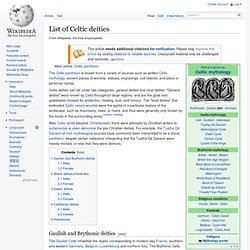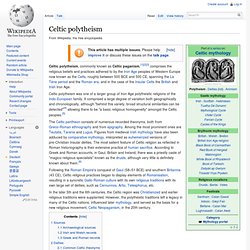

Scottish Mythology. Irish Mythology. List of Celtic deities. The Celtic pantheon is known from a variety of sources such as written Celtic mythology, ancient places of worship, statues, engravings, cult objects, and place or personal names.

Celtic deities can fall under two categories: general deities and local deities. "General deities" were known by Celts throughout large regions, and are the gods and goddesses invoked for protection, healing, luck, and honour. The "local deities" that embodied Celtic nature worship were the spirits of a particular feature of the landscape, such as mountains, trees, or rivers, and thus were generally only known by the locals in the surrounding areas. [citation needed] Gaulish and Brythonic deities[edit] Celtic pantheon.
The gods and goddesses of the pre-Christian Celtic peoples are known from a variety of sources, including written Celtic mythology, ancient places of worship, statues, engravings, cult objects and place or personal names.

In characteristic Roman fashion, Caesar does not refer to these figures by their native names but by the names of the Roman gods with which he equated them, a procedure that greatly complicates the task of identifying his Gaulish deities with their counterparts in the insular literatures. He also presents a neat schematic equation of god and function that is quite foreign to the vernacular literary testimony. Celtic polytheism. Celtic polytheism, commonly known as Celtic paganism,[1][2][3] comprises the religious beliefs and practices adhered to by the Iron Age peoples of Western Europe now known as the Celts, roughly between 500 BCE and 500 CE, spanning the La Tène period and the Roman era, and in the case of the Insular Celts the British and Irish Iron Age.

Celtic polytheism was one of a larger group of Iron Age polytheistic religions of the Indo-European family. It comprised a large degree of variation both geographically and chronologically, although "behind this variety, broad structural similarities can be detected"[4] allowing there to be "a basic religious homogeneity" amongst the Celtic peoples.[5] The Celtic pantheon consists of numerous recorded theonyms, both from Greco-Roman ethnography and from epigraphy.
Among the most prominent ones are Teutatis, Taranis and Lugus. In the later 5th and the 6th centuries, the Celtic region was Christianized and earlier religious traditions were supplanted.